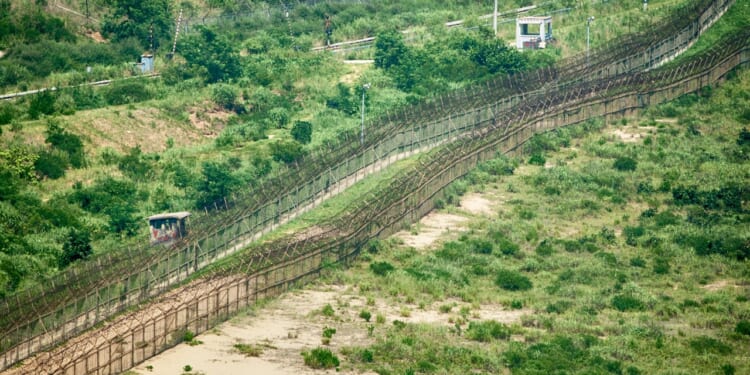Since the end of the Korean War more than 70 years ago, at least 34,000 North Koreans have defected to South Korea, but most have gone through China. It has been far less common for anyone to try crossing the demilitarized zone (DMZ), which is covered with landmines and heavily monitored by both sides. Still, it has happened at least twice this year.
In July, an unidentified North Korean man crossed the heavily fortified border and made it to South Korea, although it was not clear if he was actually trying to defect. However, that was very much the goal for another individual who crossed a central portion of the land border, the South Korean Joint Chiefs of Staff announced via a statement on Monday.
According to reports, the North Korean soldier has sought to resettle in the Republic of Korea (ROK), more commonly known as South Korea. It isn’t clear if he had come under fire during his dash for the border.
The Associated Press noted that it was “the first reported defection by a North Korean soldier since a North Korean staff sergeant fled to South Korea via the border’s eastern section in August 2024.”
The “Demilitarized Zone” Is the Most Militarized Place on the Planet
The border between the two Koreas remains so heavily defended in part because the countries aren’t technically at a state of peace. The Korean War ended with an armistice, and no formal peace treaty has been signed by the neighboring nations.
While it is described as a “Demilitarized Zone,” the DMZ is anything but demilitarized. The nearly 160-mile (250 km) long border, which runs largely across the 38th parallel from the East Sea/Sea of West to the Yellow Sea, is also 2.5 miles (4 km) wide. It contains a “Military Demarcation Line (MDL)” in the center.
It serves as a buffer, guarded by soldiers from the two Koreas around the clock. It is further fortified by landmines, tank traps, barbed wire, and other defensive measures.
Although the DMZ is essentially a death trap for humans, in their absence it has become home to wildlife—notably native birds, for whom the strip of land is now a sanctuary.
Last year, after Kim Jong-un officially abandoned North Korea’s decades-long goal of reunification with the south, additional anti-tank barriers and other fortifications were installed on its side of the border. That has made any attempts to cross the border an arduous task—but a few continue to attempt it.
North Korean Soldiers Kill Attempted Defectors
Those who have tried to fleet through the border must contend with more than just mines and barbed wire. North Korean soldiers are ordered to shoot to kill anyone attempting to flee the Hermit Kingdom. Such was the case in 2017, when a “fleeing North Korean soldier sprinted across the border,” the Associated Press explained. “North Korean soldiers fired about 40 rounds, before South Korean soldiers could drag the wounded soldier to safety.”
The individual who crossed in July may have had luck on his side, whereas the soldier who made it to freedom in the ROK may have studied the DMZ before making his attempt, and that knowledge could be shared with Seoul.
“The soldier’s likely familiarity with the area may have helped him navigate the heavily mined terrain…. The latest crossing will not be received positively by Pyongyang, as he could provide the South with information on its troop movements and operations in the border area,” Hong Min, a senior analyst at the Korea Institute for National Unification, told AFP.
The soldier, whose name hasn’t been disclosed, joins the 96 individuals who succeeded in defecting so far in 2025.
About the Author: Peter Suciu
Peter Suciu has contributed over 3,200 published pieces to more than four dozen magazines and websites over a 30-year career in journalism. He regularly writes about military hardware, firearms history, cybersecurity, politics, and international affairs. Peter is also a contributing writer for Forbes and Clearance Jobs. He is based in Michigan. You can follow him on Twitter: @PeterSuciu. You can email the author: [email protected].
Image: Shutterstock / agarose.


















